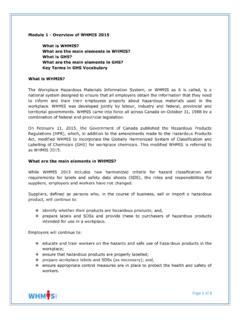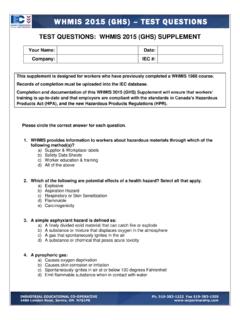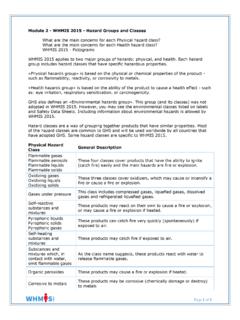Transcription of WHMIS 2015 Exam - saswh.ca
1 WHMIS 2015 Exam SASWH - 08/16;10/17 Page 1 of 3 Name: Grade: Date of Education: Educator: please print legibly Multiple Choice - these 15 questions will be graded. You must achieve 80% (a minimum of 12 right) in order to pass. 1. Some flammable products will burn when they come in contact with: a) Sparks. b) Hot surfaces. c) Lit cigarettes. d) All of the above. 2. Some products or materials are not directly covered by WHMIS laws but may be covered under other laws. These products: a) Are never hazardous. b) May also be hazardous, so you will receive training about how to work safely with them. c) Do not require safe work procedures. d) Are not important. 3. Who is responsible for ensuring that all hazardous products defined by WHMIS in the workplace have labels?
2 A) The health and safety committee. b) The employee who works most closely with the product. c) The employer and the supplier (the supplier ensures hazardous products are appropriately labelled when delivered to the employer s worksite). d) The supplier. 4. A hazard category will usually be identified with a number. Which number represents the higher or greater hazard? a) 1. b) 2. c) 3. d) 4. 5. The four important questions that are answered by the SDS are: a) Identity, disposal, hazards, and first aid. b) Identity, hazards, precautions, and emergency procedures. c) Precautions, emergency, environment, and storage. d) Hazards, transport, location, and supplier. WHMIS 2015 Exam SASWH - 08/16;10/17 Page 2 of 3 6. The components of a WHMIS program are: a) Labels.
3 B) Safety Data Sheets (SDSs). c) Education and training. d) All of the above. 7. Before using any product for the first time, you should read and understand: a) The SDS. b) The label. c) The pictogram. d) All of the above. 8. The exclamation mark pictogram is used for a number of classes and/or categories. Which of the following uses the exclamation mark pictogram? Skin irritation (Category 2). Skin sensitizer. Acute toxicity (Category 4). All of the above. 9. Hazardous products are classified into classes and categories. These classes and categories are: a) An indication of the type and degree of hazard present. b) Descriptions of the physical hazards only. c) Exclusive, meaning that a product will have one class or one category. d) Used by government to decide which products can enter the country.
4 10. Precautionary statements provide advice about storage, use, first aid, personal protective equipment, and emergency measures. You can find these statements on the: a) Label. b) SDS. c) Both the label and the SDS. d) Neither the label nor the SDS. 11. SDSs must be: a) Available in paper form. b) Available to all workers in the workplace. c) Available in the supervisor s office. d) Available electronic form. WHMIS 2015 Exam SASWH - 08/16;10/17 Page 3 of 3 12. The health hazard pictogram is used for a number of classes and/or categories. What is the common message that this pictogram represents? a) Products labelled with this pictogram may cause health effects like cancer over a long period of time. b) The product may be aspirated, meaning that it can be breathed into the lungs, which is harmful or sometimes fatal.
5 C) The products may cause allergy or asthma symptoms. d) All of the above may be represented by the health hazard pictogram. 13. The pictogram, signal word, and hazard statements work together to tell you about: a) The hazard class of the product. b) The cost of the product. c) The degree of the hazard. d) The three elements have no meaning when placed together. 14. A product may belong to: a) Only one class. The classes are mutually exclusive. b) Only two classes. c) All classes for which it meets the criteria. d) Up to three classes. 15. You find a container of a hazardous product at work, but the label is missing. What should you do? a) Ignore it and walk away. b) Go get the supervisor, identify the product together, and replace the label. c) Smell it to see what the product is.
6 D) Work with the product anyway. Questions for this exam were obtained from SASWH s WHMIS 2015 online learning program. SASWH acknowledges the Canadian Centre for Occupational Health and Safety (CCOHS) for the development of the WHMIS 2015 program and exam.






